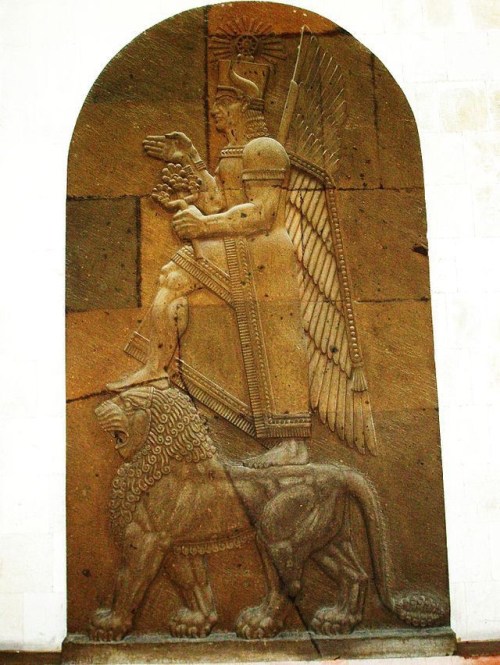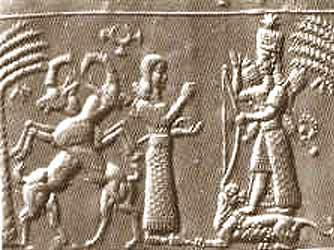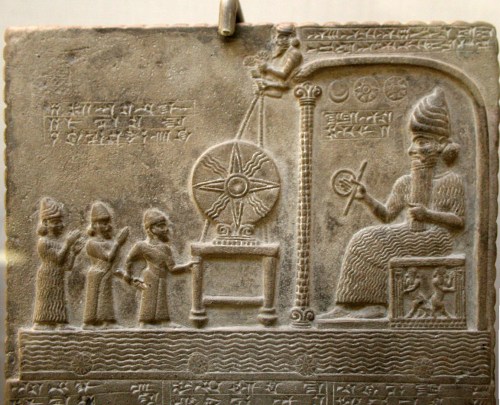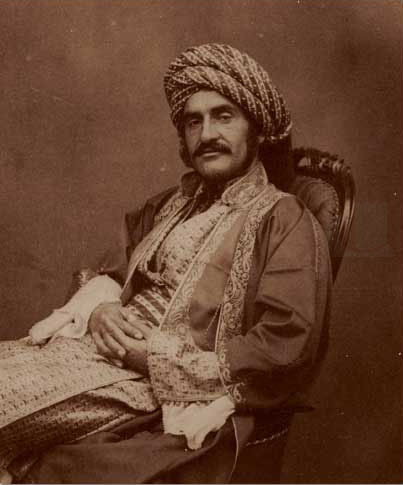Nergal the Destroyer
“The library of Nineveh contained the copy of a tablet which, according to its concluding lines, was originally written for the great temple of Nergal at Cutha. The words of the text are put in the mouth of Nergal the destroyer, who is represented as sending out the hosts of the ancient brood of chaos to their destruction.

Nergal appears at the top, leering over a top register which contains the eight-pointed star of Ishtar and the inverted half-moon crescent of the Moon God Sin.
In the second register, seven demons appear to support the heavens.
The middle register depicts the burial rites for new arrivals in the underworld.
The lower register depicts the goddess Allat, or Ereshkigal, sister of Ishtar, who reigns in the underworld. She kneels upon a horse, which appears to be oppressed by her burden, in a boat which floats upon the waters of life. Note the lions suckling at her breast.
Drawn by Faucher-Gudin, from a bronze plaque of which an engraving was published by Clermont-Ganneau.
The original, which belonged to M. Péretié, is now in the collection of M. de Clercq.
http://www.gutenberg.org/files/17323/17323-h/17323-h.htm#linkBimage-0039
Nergal is identified with Nerra, the plague-god, who smites them with pestilence, or rather with Ner, the terrible “king who gives not peace to his country, the shepherd who grants no favour to his people.”
We are first told how the armies of chaos came into existence.
“On a tablet none wrote, none disclosed, and no bodies or brushwood were produced in the land; and there was none whom I approached.
Warriors with the body of a bird of the valley, men with the faces of ravens, did the great gods create. In the ground did the gods create their city. Tiamat (the dragon of chaos) suckled them. Their progeny (sasur) the mistress of the gods created.
In the midst of the mountains they grew up and became heroes and increased in number. Seven kings, brethren, appeared and begat children. Six thousand in number were their peoples. The god Banini their father was king; their mother was the queen Melili.”
It was the subjects and the offspring of these semi-human heroes whom the god Ner was deputed to destroy.

The reverse side of the god Nergal, drawn by Faucher-Gudin. This is the back of the bronze plate above; the animal-head of the god appears in relief at the top of the illustration.
http://www.gutenberg.org/files/17323/17323-h/17323-h.htm#linkBimage-0018
It is clear that the legend of Cutha agrees with Berossos in the main facts, however much it may differ in details. In both alike, we have a first creation of living beings, and these beings are of a composite nature, and the nurselings of Tiamat or Chaos.
In both alike, the whole brood is exterminated by the gods of light. A curious point in connection with the legend is the description of chaos as a time when writing was as yet unknown and records unkept. Perhaps we may see in this an allusion to the fact that the Babylonian histories of the pre-human period were supposed to have been composed by the gods.
The date to which the legend in its present form may be assigned is difficult to determine. The inscription is in Semitic only, like the other creation-tablets, and therefore cannot belong to the pre-Semitic age. It belongs, moreover, to an epoch when the unification of the deities of Babylonia had already taken place, and the circle of “the great gods” was complete.
Ea, Istar, Zamama, Anunit, even Nebo and “Samas the warrior,” are all referred to in it. We must therefore place its composition after the rise not only of the hymns of Sippara, but also of the celebrity of the Semitic god of Borsippa.
On the other hand, the reference to the pateśi or priest-king in the concluding lines seems to prevent us from assigning too late a date to the poem. Perhaps we shall not be far wrong in ascribing it to the era of Khammuragas.”
A.H. Sayce, Lectures on the Origin and Growth of Religion as Illustrated by the Religion of the Ancient Babylonians, 5th ed., London, 1898, pp. 372-4.













